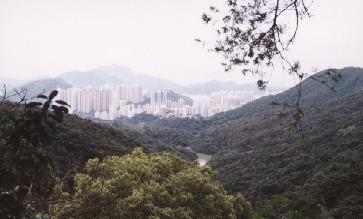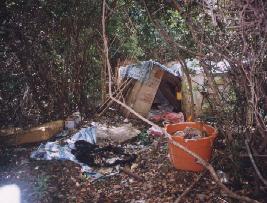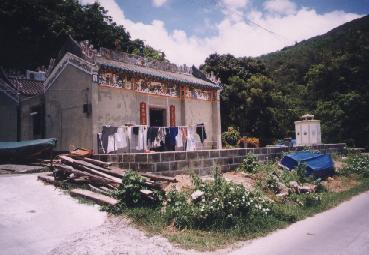 |
Hong Kong may be unique with densely populated urban areas and dense sub-tropical forests side by side in steeply hilly terrain. |
|
|
| |
|
 This is an example of an "armchair" grave, so called because of the wide curving arms that extend to each side. They can be found throughout Hong Kong's territories in the less urban areas, usually high on a hillside overlooking the sea, the preferred fung shui site. Many of the graves are quite old. Others are obviously the site of fresh burials. There seems to be little restriction on where people can be buried, and some hillsides--the "best" locations because of the relation to the wind and water--can be quite crowded. The social status and wealth of a person can be indicated by the size of the grave, its ornate design, and the decoration and type of name stone that is affixed to it.
This is an example of an "armchair" grave, so called because of the wide curving arms that extend to each side. They can be found throughout Hong Kong's territories in the less urban areas, usually high on a hillside overlooking the sea, the preferred fung shui site. Many of the graves are quite old. Others are obviously the site of fresh burials. There seems to be little restriction on where people can be buried, and some hillsides--the "best" locations because of the relation to the wind and water--can be quite crowded. The social status and wealth of a person can be indicated by the size of the grave, its ornate design, and the decoration and type of name stone that is affixed to it. |
|
|
|
| |
|
 Approximately 200 illegal immigrants sneak into Hong Kong from China every day. About that many are caught each day and eventually returned to China. Sometimes when I am walking in the woods I find places where the IIs, as they are known, have been living. Here is one abandoned little hut near a major construction site in Stanley. The plastic roofing material, lights, and heavy duty batteries have all been "borrowed" from the construction area. Hiking alone can be somewhat hazardous in some areas where hikers have been robbed by IIs hiding along the trails. Usually few IIs are found on Hong Kong Island--more are on the mainland, nearer the border--but some gravitate toward areas on Hong Kong where they know there are concentrations of houses of well-to-do expatriates that can be burgled. Approximately 200 illegal immigrants sneak into Hong Kong from China every day. About that many are caught each day and eventually returned to China. Sometimes when I am walking in the woods I find places where the IIs, as they are known, have been living. Here is one abandoned little hut near a major construction site in Stanley. The plastic roofing material, lights, and heavy duty batteries have all been "borrowed" from the construction area. Hiking alone can be somewhat hazardous in some areas where hikers have been robbed by IIs hiding along the trails. Usually few IIs are found on Hong Kong Island--more are on the mainland, nearer the border--but some gravitate toward areas on Hong Kong where they know there are concentrations of houses of well-to-do expatriates that can be burgled.
|
|
|
|
| |
|
 Small temples are abundant all over the territory of Hong Kong. This small one on Lantau island illustrates nicely the Chinese preference for function over form, i.e., as long as you can go in and do what you need to do in the temple, it doesn't matter that the wash is hanging out or that a boat, junk, and construction materials are piled about. Small temples are abundant all over the territory of Hong Kong. This small one on Lantau island illustrates nicely the Chinese preference for function over form, i.e., as long as you can go in and do what you need to do in the temple, it doesn't matter that the wash is hanging out or that a boat, junk, and construction materials are piled about.
|
|
|
|
| (More photos to come) |
|
>

 This is an example of an "armchair" grave, so called because of the wide curving arms that extend to each side. They can be found throughout Hong Kong's territories in the less urban areas, usually high on a hillside overlooking the sea, the preferred fung shui site. Many of the graves are quite old. Others are obviously the site of fresh burials. There seems to be little restriction on where people can be buried, and some hillsides--the "best" locations because of the relation to the wind and water--can be quite crowded. The social status and wealth of a person can be indicated by the size of the grave, its ornate design, and the decoration and type of name stone that is affixed to it.
This is an example of an "armchair" grave, so called because of the wide curving arms that extend to each side. They can be found throughout Hong Kong's territories in the less urban areas, usually high on a hillside overlooking the sea, the preferred fung shui site. Many of the graves are quite old. Others are obviously the site of fresh burials. There seems to be little restriction on where people can be buried, and some hillsides--the "best" locations because of the relation to the wind and water--can be quite crowded. The social status and wealth of a person can be indicated by the size of the grave, its ornate design, and the decoration and type of name stone that is affixed to it. Approximately 200 illegal immigrants sneak into Hong Kong from China every day. About that many are caught each day and eventually returned to China. Sometimes when I am walking in the woods I find places where the IIs, as they are known, have been living. Here is one abandoned little hut near a major construction site in Stanley. The plastic roofing material, lights, and heavy duty batteries have all been "borrowed" from the construction area. Hiking alone can be somewhat hazardous in some areas where hikers have been robbed by IIs hiding along the trails. Usually few IIs are found on Hong Kong Island--more are on the mainland, nearer the border--but some gravitate toward areas on Hong Kong where they know there are concentrations of houses of well-to-do expatriates that can be burgled.
Approximately 200 illegal immigrants sneak into Hong Kong from China every day. About that many are caught each day and eventually returned to China. Sometimes when I am walking in the woods I find places where the IIs, as they are known, have been living. Here is one abandoned little hut near a major construction site in Stanley. The plastic roofing material, lights, and heavy duty batteries have all been "borrowed" from the construction area. Hiking alone can be somewhat hazardous in some areas where hikers have been robbed by IIs hiding along the trails. Usually few IIs are found on Hong Kong Island--more are on the mainland, nearer the border--but some gravitate toward areas on Hong Kong where they know there are concentrations of houses of well-to-do expatriates that can be burgled.
 Small temples are abundant all over the territory of Hong Kong. This small one on Lantau island illustrates nicely the Chinese preference for function over form, i.e., as long as you can go in and do what you need to do in the temple, it doesn't matter that the wash is hanging out or that a boat, junk, and construction materials are piled about.
Small temples are abundant all over the territory of Hong Kong. This small one on Lantau island illustrates nicely the Chinese preference for function over form, i.e., as long as you can go in and do what you need to do in the temple, it doesn't matter that the wash is hanging out or that a boat, junk, and construction materials are piled about.